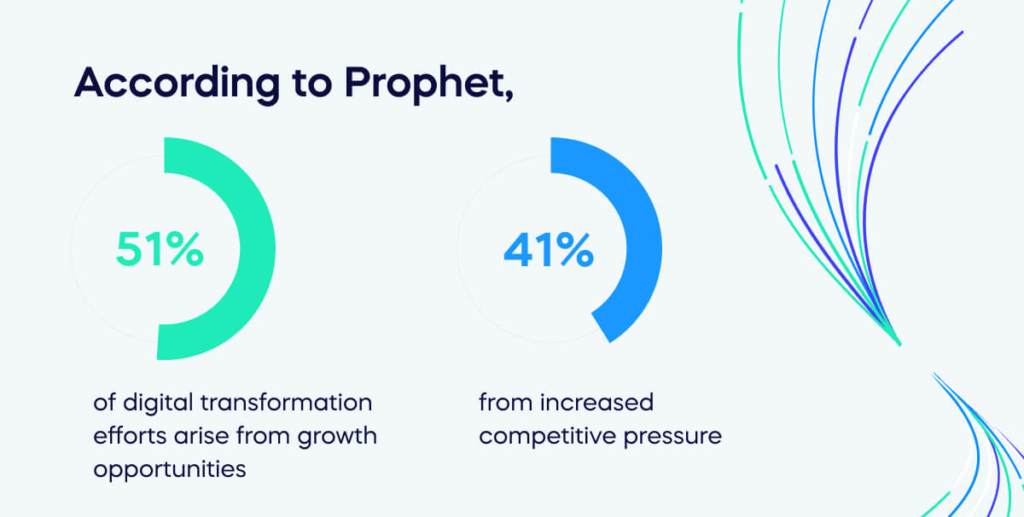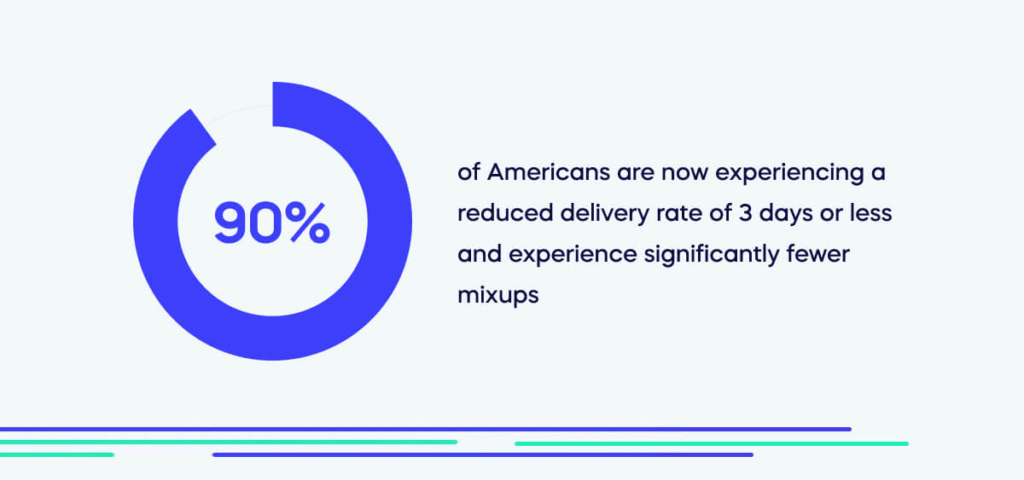Digital transformation is the word on everyone’s lips in this modern business landscape.
It’s an arms race to see who can use digital transformation to drive value higher and costs lower than anyone else— and if you’re not playing the digital transformation game, you run the risk of getting left in the dust.
According to Gartner, a staggering 91% of businesses are engaged in some form of digital initiative. When everyone is doing digital transformation, how do you stand out?
By looking to the cream of the crop— the most successful enterprises you can think of— and breaking down their digital transformation success, you could get a leg up on the competition. Rather than using digital adoption as a means of keeping up, you can start using it as a means of driving business growth.
That’s why in this article, we’re looking at 7 successful digital transformation examples from enterprises so successful they’re basically household names.
We’re going to talk about:
- Comcast’s use of machine learning to enhance the customer journey.
- Netflix’s shift to a cloud-based, on-demand model emphasizing customer-centric strategies.
- Nike’s adoption of data analytics and in-house production for an omnichannel customer experience.
- Nestlé’s ‘Vision2Life’ strategy emphasizing innovation and customer engagement through artificial intelligence (AI).
- Spotify’s team restructuring to prioritize creativity and improved user experience.
- Sephora’s creation of a digital hub, introducing augmented reality (AR) and beacon-driven innovations for an omni-channel experience.
- UPS’s $20B e-commerce investment and ‘ORION’ system to optimize delivery and reduce times.
What is digital transformation?

Further benefits include:
- Improves organizational efficiency
- Boosts employee productivity
- Limits costly human error
- Raises customer and employee satisfaction
- Increases cross-enterprise agility
- Provides access to valuable enterprise data
- Enables scalable training & onboarding
The need for digital transformation
According to our 2022-2023 State of Digital Adoption report, 67% of enterprises are under “incredible pressure” to accelerate digital transformation.
But where is this mounting pressure coming from?

According to Prophet, 51% of digital transformation efforts arise from growth opportunities and 41% from increased competitive pressure.

And that’s not where it stops— significant pressure comes from the top, as according to Gartner, 87% of senior business leaders say digitalization is a priority.
All this goes to show:
Digital transformation might be the single most important thing you should do to drive growth.
And with that, let’s explore some digital transformation examples to inspire and educate you.
7 top enterprises, and how they achieved digital transformation

When trying to make a change, reviewing some examples of success stories is always helpful.
Here are 7 noteworthy digital transformations by major enterprises to gain inspiration from. Keep reading to learn how these companies did it.
1. Comcast
Comcast innovated new products, including voice-activated controls and a cloud-based video platform for watching TV.
But this didn’t result in the boost in customer satisfaction they expected.
So, citing the “accelerated adoption of digital technologies brought on by the pandemic,” the $84-billion U.S. media and communications company reorganized, putting product innovation and customer experience together.
With this transformation, Comcast created a highly personalized experience that uses machine learning to recommend content.
Additionally, Comcast tracked the impact of its offerings through IT investments, customer care, technology usage, and accounting to ensure a smooth and cost-effective customer experience.
This example shows how basing digital transformation on the customer experience lets you understand and address all your touch-points and how you interact with your audiences— from the marketing campaigns they see to the sales personnel and processes they encounter and where they first connect with your company.
2. Netflix
Where Blockbuster went wrong, Netflix went right. Netflix based its digital transformation strategy on the customer.
Netflix, which originally began with a business model based on direct mail, unlocked its superpower potential when they moved to a cloud-based, on-demand model.
Even before that, focusing on the customer experience, they deployed an online recommendation engine to help customers find shows they like based on their interests and tastes and let customers know which videos were out of stock— meaning they could avoid going to video rental stores altogether.
In 2002, Netflix had 857K subscribers and $152.8M in revenue.
17 years years later, in 2019, they had 151.5M subscribers and $15.794B in revenue. Their biggest competitor in 2002, Blockbuster, tried to protect its bottom line with tactics like late fees, but this ultimately garnered hostility, was disliked by customers, and the rest is history.
3. Nike
When Nike felt they were getting a bit dated and sluggish, they underwent a digital transformation.
The brand focused more on data analytics, updated its e-commerce strategy, developed stronger digital marketing campaigns, and increased direct-to-customer sales.
The brand took production capabilities in-house to allow for market agility and invested in robotics and 3D printing.
With this, Nike was able to open concept stores, create more membership opportunities, and improve the overall customer experience by using digital consumer data more effectively alongside an omnichannel contact center.
4. Nestlé
The largest public food company in the world, Nestlé underwent a major digital transformation to enable advancement and scaling within the enterprise.
The strategy they followed was named ‘Vision2Life’, and its purpose was four-fold:
- Bring value to receivers of IT services
- Maintain global synchronization while operating locally
- Merge product management and business stakeholders
- Make the IT department an innovator, not just a service provider
In Nestlé’s annual investor report, they stated that the changes were about creating business value driven by data and technology.
Their goal? To create an exceptional customer experience through engagement and more efficient operations.
The conglomerate strives to achieve this using future-forward technologies, including AI.
In their words, Nestlé will achieve this by “creating channel-less ecosystems, advancing always-on analytics, expanding connected operations, and supporting sustainability.”
Discover how Nestlé partnered with WalkMe to boost employee digital adoption and drive organizational transformation.
5. Spotify
In order to provide superior customer value and scale internally, Swedish streaming platform Spotify shifted its focus to customer engagement metrics and its internal structure.
Having seen success from expanding their offerings— from just music to adding podcasts, live audio, and audiobooks— the enterprise knew that further transformation couldn’t hurt.
In the first phase of the plan, Spotify took their team structure back to the drawing board.
Having reworked it entirely, they ended up with an organizational layout that created a culture that rewards creativity and experimentation.
Each product within the Spotify ecosystem is owned by a team made up of individuals with varying expertise.
This structure allows diverse skill sets to come together, resulting in exceptionally well-designed products that enhance user experience— the cornerstone of successful digital transformation.
6. Sephora
In 2015, beauty store extraordinaire Sephora made a serious commitment to innovating when they turned one of their warehouses— previously a test site for retail stores— into a digital transformation hub.
The hub was dedicated to developing digital solutions that would create seamless customer experiences across physical and online spaces.
On top of their innovation lab, Sephora released a myriad of new offerings, including:
- The Pocket Contour app, which provides contouring tutorials based on users’ individual face shapes
- Beacon-driven (IoT location-based broadcasting devices) notifications to provide on-time and personalized notifications to in-store customers
- Sephora Flash for ultra-fast, free shipping
- Virtual Artist app (2016), which uses augmented reality (AR) to let users try on makeup virtually before buying
In the digital space, Sephora added features such as AI-driven chatbots that enable users to book appointments and the ability to effortlessly find and buy makeup tested using Virtual Artist on the Sephora app and website.
These introductions resulted in a frictionless, personalized customer experience thanks to a true omni-channel experience.
7. UPS
In a bid to improve customer experience, courier company UPS has designed a comprehensive digital transformation strategy.
UPS is no stranger to digital transformation, having invested in technology and IT infrastructure for decades.
UPS maintained an incredible on-time delivery rate throughout the COVID-19 pandemic— even when industry rates dropped.
In 2018, it was announced that UPS would invest $20B into e-commerce. A large part of that sum has gone to data and analytics command centers featuring IoT sensors, cameras, and Network Planning Tools (NPTs).
These technologies allow the company to track the whopping two million packages processed per day in their facilities.
Additionally, UPS rolled out ‘ORION’ – “on-road integrated optimization and navigation,” a fleet telematics system using advanced algorithms to constantly optimize delivery routes on:
- Distance
- Fuel
- Time
- Environmental impact
The result of all these initiatives?
90% of Americans are now experiencing a reduced delivery rate of 3 days or less and experience significantly fewer mixups.

What can we learn from these digital transformation examples?
What have we learned from how Comcast, Netflix, Nike, Nestle, Spotify, Sephora, and UPS achieved digital transformation?
For one thing, we’ve learned that a customer-centric approach is the key to success.
These enterprises strayed from the traditional business model that follows a typical ‘spray and pray’ approach— mass production and mass distribution.
However, the other element shared by these companies’ digital transformation journeys is data.
All seven enterprises provided their employees with copious amounts of customer data and implemented systems that improved their workflows.
This shows that digital transformation begins when employees are empowered with systems and technologies that enable new levels of efficiency.
Additionally, following the changes they made to their business models, each of these enterprises experienced significant data-fueled growth based on exceptional user experience.
Explore our customer stories to learn how WalkMe helped our customers achieve successful digital transformation.


